| کد مقاله | کد نشریه | سال انتشار | مقاله انگلیسی | نسخه تمام متن |
|---|---|---|---|---|
| 93196 | 160116 | 2013 | 11 صفحه PDF | دانلود رایگان |
• How does ‘Free, Prior and Informed Consent’ improve equity in resource interventions?
• In mining and forestry, this depends on who participates and how.
• FPIC is more enabling for those with strong tenure and legal rights.
• Explicit analysis of ‘who counts’ is often neglected.
• FPIC's spatial and temporal boundaries also limit the scope of equity.
The principle of “Free, Prior and Informed Consent” (FPIC) is promoted through international agreements and safeguards in order to strengthen social equity in resource management by requiring consent from indigenous and/or local communities prior to actions that affect their land and resource rights. Based on early experiences with implementing FPIC standards in mining and forestry, we examine how FPIC has impacted social equity and why. In both sectors FPIC was first operationalized through non-governmental standards that revealed ambiguities surrounding its definition and implementation. In mining, FPIC was first codified in the standards of financial investors, while in forestry FPIC emerged within competing market-based certification schemes, resulting in contrasting definitions. In both sectors, contextual factors such as government laws and policies, the socio-political environment and the overall distribution of rights and resources strongly shape the impacts of FPIC on equity particularly for actors without strong legal rights. These findings are significant for emerging arenas such as REDD+, where there is much debate around the role of governments, financial institutions and market-based actors in applying FPIC for social equity outcomes.
Journal: Land Use Policy - Volume 35, November 2013, Pages 406–416
